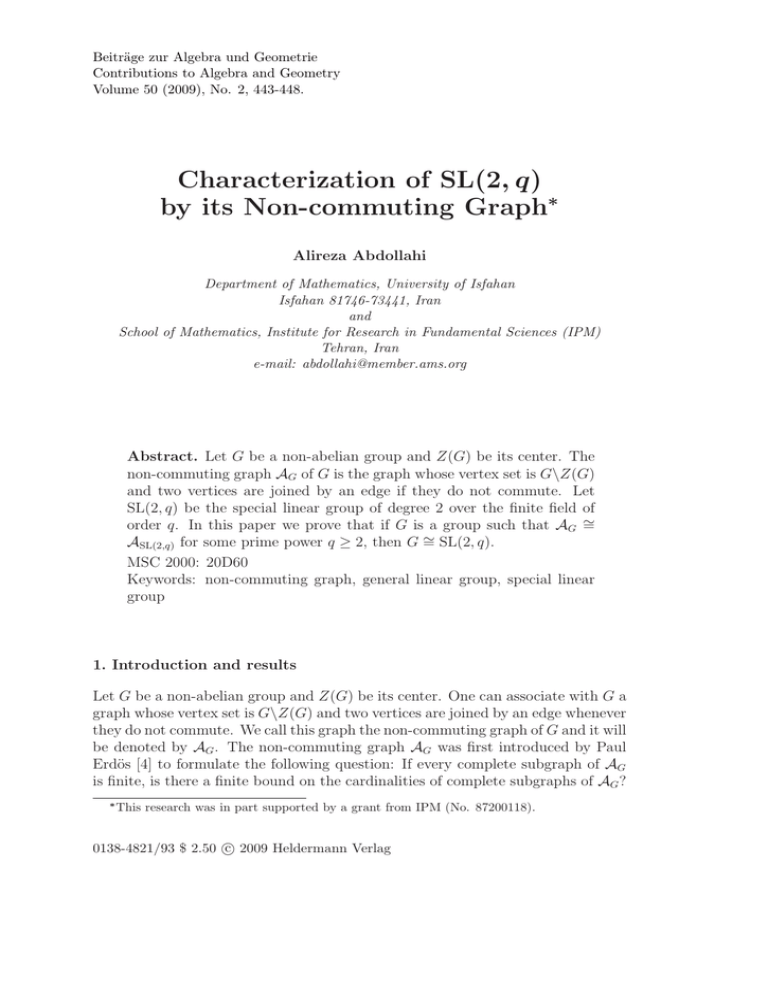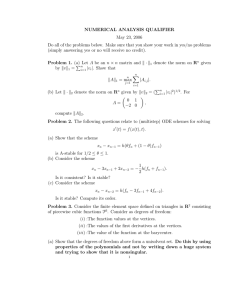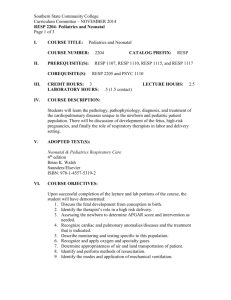Beitr¨ age zur Algebra und Geometrie Contributions to Algebra and Geometry
advertisement

Beiträge zur Algebra und Geometrie
Contributions to Algebra and Geometry
Volume 50 (2009), No. 2, 443-448.
Characterization of SL(2, q)
by its Non-commuting Graph∗
Alireza Abdollahi
Department of Mathematics, University of Isfahan
Isfahan 81746-73441, Iran
and
School of Mathematics, Institute for Research in Fundamental Sciences (IPM)
Tehran, Iran
e-mail: abdollahi@member.ams.org
Abstract. Let G be a non-abelian group and Z(G) be its center. The
non-commuting graph AG of G is the graph whose vertex set is G\Z(G)
and two vertices are joined by an edge if they do not commute. Let
SL(2, q) be the special linear group of degree 2 over the finite field of
order q. In this paper we prove that if G is a group such that AG ∼
=
ASL(2,q) for some prime power q ≥ 2, then G ∼
= SL(2, q).
MSC 2000: 20D60
Keywords: non-commuting graph, general linear group, special linear
group
1. Introduction and results
Let G be a non-abelian group and Z(G) be its center. One can associate with G a
graph whose vertex set is G\Z(G) and two vertices are joined by an edge whenever
they do not commute. We call this graph the non-commuting graph of G and it will
be denoted by AG . The non-commuting graph AG was first introduced by Paul
Erdös [4] to formulate the following question: If every complete subgraph of AG
is finite, is there a finite bound on the cardinalities of complete subgraphs of AG ?
∗
This research was in part supported by a grant from IPM (No. 87200118).
c 2009 Heldermann Verlag
0138-4821/93 $ 2.50 444
A. Abdollahi: Characterization of SL(2, q) . . .
Neumann [4] answered positively Erdös question by proving that |G : Z(G)| = n
is finite and n is obviously the requested finite bound.
The non-commuting graph has been studied by many people (see e.g., [1],
[3] and [5]). It is proved in [7] (resp. in [8]) that if G is a finite group with
AG ∼
= APSL(2,q) (resp. AG ∼
= AA10 ), then G ∼
= PSL(2, q) (resp., G ∼
= A10 ). For any
prime power q, let GL(2, q) (resp. SL(2, q)) be the general (resp. special) linear
group of degree 2 over the finite field of order q. In this paper we study the groups
whose non-commuting graphs are isomorphic to either GL(2, q) or SL(2, q). Our
main results are the following.
Theorem 1.1. Let G be a group such that AG ∼
= AGL(2,q) for some prime power
0 ∼
∼
q > 3. Then G/Z(G) = PGL(2, q), G = SL(2, q) and Z(G) is of order q − 1. In
particular, if q is even, then G = G0 × Z(G).
Theorem 1.2. Let G be a group such that AG ∼
= ASL(2,q) for some prime power
q ≥ 2. Then G ∼
= SL(2, q).
For any prime power q, we denote by PGL(2, q) (resp. PSL(2, q)) the projective
general (resp. special) linear group of degree 2 over the finite field of order q.
2. Proofs
Here for convenience, we remind some of the properties of non-commuting graphs
and common properties of groups with isomorphic non-commuting graphs.
Let G and H be two non-abelian groups such that AG ∼
= AH . By Lemma
3.1 of [1], if one of G or H is finite, then so is the other. The order of AG is
|G| − |Z(G)| and so |G| − |Z(G)| = |H| − |Z(H)|. The degree of a vertex x in AG
is equal to |G| − |CG (x)|. Thus the multisets of degrees of vertices of two graphs
AG and AH are the same.
A non-abelian group G is called an AC-group, if the centralizer CG (x) of every
non-central element x of G is abelian.
Recall that a non-empty subset X of the vertices of a simple graph Γ is called
independent if every two distinct vertices of X are not joint by an edge in Γ. Thus
an independent set S of the non-commuting graph of a group is a set of pairwise
commuting non-central elements of the group.
Lemma 2.1. Let G and H be two finite non-abelian groups with AG ∼
= AH .
(1) If |G| = |H|, then the multisets (sets with multiplicities) {|CG (g)| : g ∈
G\Z(G)} and {|CH (h)| : h ∈ H\Z(H)} are equal.
(2) If G is an AC-group, then H is also an AC-group.
Proof. (1) It is straightforward, if we note that the set of non-adjacent vertices
to a vertex x in the non-commuting graph H is CH (x)\Z(H), and note that from
|G| = |H| we also have |Z(G)| = |Z(H)|, since |H| − |Z(H)| = |G| − |Z(G)|.
(2) Note that a subgroup S of a non-abelian group K is abelian if and only if
either S\Z(S) is empty or S\Z(S) is an independent set in the non-commuting
A. Abdollahi: Characterization of SL(2, q) . . .
445
graph AK . Let φ be a graph isomorphism from AH onto AG . Then it is easy to
see that for each h ∈ H\Z(H),
CH (h)\Z(H) = φ−1 CG (φ(h))\Z(G) .
(∗)
Now since G is an AC-group, CG (g) is abelian for all g ∈ G\Z(G) and so it
follows from (∗) and the remark above that CH (h) is abelian. Hence H is also an
AC-group.
Finite non-nilpotent AC-groups were completely characterized by Schmidt [6].
We use the following results in our proofs.
Theorem 2.2. ([6, Satz 5.9.]) Let G be a finite non-solvable group. Then G is
an AC-group if and only if G satisfies one of the following conditions:
1. G/Z(G) ∼
= PSL(2, pn ) and G0 ∼
= SL(2, pn ), where p is a prime and pn > 3.
2. G/Z(G) ∼
= PGL(2, pn ) and G0 ∼
= SL(2, pn ), where p is a prime and pn > 3.
3. G/Z(G) ∼
= PSL(2, 9) and G0 is a covering group of A6 . In particular, G0 is
isomorphic to
A∼
=< c1 , c2 , c3 , c4 , k | c31 = c22 = c23 = c24 = (c1 c2 )3 = (c1 c3 )2 =
= (c2 c3 )3 = (c3 c4 )3 = k 3 , (c1 c4 )2 = k,
c2 c4 = k 3 c4 c2 , kci = ci k(i = 1, . . . , 4), k 6 = 1 > .
4. G/Z(G) ∼
= A.
= PGL(2, 9) and G0 ∼
For a finite simple graph Γ, we denote by ω(Γ) the maximum size of a complete
subgraph of Γ. So ω(AG ) is the maximum number of pairwise non-commuting
elements in a finite non-abelian group G.
Theorem 2.3. (Satz 5.12 of [6]) Let G be a finite non-abelian solvable group.
Then G is an AC-group if and only if G satisfies one of the following properties:
1. G is non-nilpotent and it has an abelian normal subgroup N of prime index
and ω(AG ) = |N : Z(G)| + 1.
2. G/Z(G) is a Frobenius group with Frobenius kernel and complement F/Z(G)
and K/Z(G), respectively and F and K are abelian subgroups of G; and ω(AG )
= |F : Z(G)| + 1.
3. G/Z(G) is a Frobenius group with Frobenius kernel and complement F/Z(G)
and K/Z(G), respectively; and K is an abelian subgroup of G, Z(F ) = Z(G),
and F/Z(G) is of prime power order; and ω(AG ) = |F : Z(G)| + ω(AF ).
4. G/Z(G) ∼
= S4 and V is a non-abelian subgroup of G such that V /Z(G) is the
Klein 4-group of G/Z(G); and ω(AG ) = 13.
5. G = A × P , where A is an abelian subgroup and P is an AC-subgroup of prime
power order.
446
A. Abdollahi: Characterization of SL(2, q) . . .
Proof of Theorems 1.1 and 1.2. Let q1 = pn1 1 > 3 and q2 = pn2 2 ≥ 2, where p1 and
p2 are two prime numbers. Let M1 = GL(2, q1 ) and M2 = SL(2, q2 ) and suppose
that G1 and G2 are two groups such that AGi ∼
= AMi for i = 1, 2.
If q1 = 2, then M2 ∼
= S3 is the symmetric group of degree 3 and so by Proposition
3.2 of [1], G2 ∼
= M2 . If q2 = 3, then M2 is a group of order 24 and its center has
order 2. As there is some element g with |CG2 (g)| = 6, we see that there is no
normal Sylow 3-subgroup in G2 . Hence G2 /Z(G2 ) ∼
= A4 . So either G2 ∼
= M2 or
Z2 × A4 . But as there are elements h ∈ G2 with |CG2 (h)| = 4, we have G2 ∼
= M2 .
Now let q2 > 3. If q2 is even, then PSL(2, q2 ) ∼
= M2 and so AG2 ∼
= APSL(2,q2 ) .
Then by Corollary 5.3 of [1], G2 ∼
= PSL(2, q2 ) ∼
= M2 . Therefore we may assume
that q2 ≥ 5 is odd.
By Proposition 4.3 of [1], |Gi | = |Mi | for i = 1, 2. By Lemma 3.5 of [1],
Mi ’s are AC-groups and so by Lemma 2.1(2) Gi ’s are also AC-groups. Now since
AGi ∼
= AMi and |Gi | = |Mi |, by Lemma 2.1 we have the following equality between
multisets
Wi = {|CGi (x)| | x ∈ Gi \Z(Gi )} = {|CMi (g)| | g ∈ Mi \Z(Mi )}, i = 1, 2.
Also, since the order of two graphs AGi and AMi are the same, we have that
|Gi | − |Z(Gi )| = |Mi | − |Z(Mi )| and so |Z(Gi )| = |Z(Mi )| (i = 1, 2). Therefore,
it follows from Propositions 3.14 and 3.26 of [1] that the multiset W1 (resp. W2 )
consists of three distinct integers (q1 −1)2 (resp. (q2 −1)/2), q12 −1 (resp. (q2 +1)/2)
and q1 (q1 − 1) (resp. q2 ) with multiplicities qi (q2i +1) , qi (q2i −1) and qi + 1, respectively.
We claim that both groups G1 and G2 are not nilpotent. Suppose, for a contradiction, that Gi is nilpotent, then so is Gi /Z(Gi ). Therefore Gi /Z(Gi ) has only
one Sylow pi -subgroup. Since W1 (resp., W2 ) contains qi + 1 elements all equal
to q1 (q1 − 1) (resp., q2 ), there exist two non-central elements x1 and y1 in G1
(resp., x2 and y2 in G2 ) such that CG1 (x1 ) 6= CG1 (y1 ) and |CG1 (x1 )| = |CG1 (y1 )| =
q1 (q1 − 1) (resp., CG2 (x2 ) 6= CG2 (y2 ) and |CG2 (x2 )| = |CG2 (y2 )| = 2q2 ). Since
CGi (xi )/Z(Gi ) and CGi (yi )/Z(Gi ) are of the same order qi , they are Sylow pi subgroups of Gi /Z(Gi ). It follows that CGi (xi )/Z(Gi ) = CGi (yi )/Z(Gi ) and so
CGi (xi ) = CGi (yi ), a contradiction.
Now we prove that both G1 and G2 cannot be solvable. Suppose, for a contradiction, that Gi ’s are solvable. Then since Gi are not nilpotent, it follows from
Theorem 2.3 that Gi ’s satisfy one of properties (1)–(4) in Theorem 2.3. Since
qi > 3 is a prime power and q2 is odd, both of |G1 /Z(G1 )| = q1 (q12 − 1) and
q (q 2 −1)
|G2 /Z(G2 )| = 2 22
cannot equal to |S4 | = 24. Therefore Gi ’s do not satisfy
(4). If Gi satisfies either (1) or (2), then Wi contains only two distinct elements,
since in the case (1), if x ∈ N \Z(G
i ), then CGi (x) =
N ; and if x ∈ G\N then
CN (x) = Z(Gi ); so |CGi (x)| ∈ |Gi : N ||Z(Gi )|,
|N
|
for
every non-central element x ∈ Gi , and in the case (3), |CGi (x)| ∈ |K|, |F | . This is not possible,
since Wi has exactly three distinct elements.
Finally, suppose that Gi satisfies (3). Note that CGi (x) = CF (x) for every noncentral element x ∈ F and CGi (x) is equal to the conjugate of K which contains the
non-central element x. It follows that the three distinct elements of the multiset
447
A. Abdollahi: Characterization of SL(2, q) . . .
Wi0 = {w/|Z(G)| | w ∈ Wi } are |K/Z(Gi )|, rk , r` , where |F/Z(G)| = rm and r is
a prime number. This is impossible, since no two of the numbers q1 , q1 + 1 or
q1 − 1 (resp., q2 , (q2 + 1)/2 or (q2 − 1)/2) can simultaneously be powers of the
same prime.
Hence Gi ’s are finite non-solvable AC-groups. By Theorem 2.2, Gi ’s satisfy one
of the conditions (1)–(4) stated in Theorem 2.2. If Gi satisfies (3), then as A6 has
self-centralizing elements of order 4 and 5, Gi contains two elements xi , yi such
CGi (xi )
CGi (yi )
that | Z(G
| = 4 and | Z(G
| = 5. This implies that q1 ∈ {4, 5} and q2 = 9.
i)
i)
Therefore |G1 /Z(G1 )| = 4 · (42 − 1) or 5 · (52 − 1), which is impossible, since
2
|G1 /Z(G1 )| = |PSL(2, 9)| = 9·(92−1) . Since M2 = SL(2, 9), |Z(M2 )| = 2. But 3
divides Z(G2 ) by Theorem 2.2, a contradiction.
If Gi satisfies (4), then as PGL(2, 9) contains self-centralizing elements of order 8
CGi (ti )
CGi (si )
and 10, Gi contains two elements ti and si such that | Z(G
| = 8 and | Z(G
| = 10.
i)
i)
q2 −1 q2 −1
It follows that {8, 10} ⊂ {q2 , 2 , 2 }, which is a contradiction as q2 is a prime
power; and for i = 1, it follows that q1 = 9. Hence |Z(M1 )| = 8. But 3 divides
|Z(G1 )|, a contradiction. Thus Gi does not satisfy both (3) and (4).
Now suppose that Gi satisfies either (1) or (2). The group PGL(2, rm ) (resp.
m
m
PSL(2, rm )) has a partition P consisting of rm + 1 Sylow r-subgroups, (r +1)r
2
(rm −1)r m
r m −1
cyclic subgroups of order rm − 1 (resp. gcd(2,r
cyclic subm −1) ) and
2
m
r +1
groups of order rm + 1 (resp. gcd(2,r
m −1) ) (see pp. 185–187 and p. 193 of [2]).
Now [6, (5.3.3) in p. 112] states that if x ∈ Gi \Z(Gi ), then CGi (xi )/Z(Gi ) belongs to P. Suppose that Gi /Z(Gi ) ∼
= PGL(2, rm ) (resp. PSL(2, rm )). Thus
there exist elements gi1 , gi2 , gi3 ∈ Gi \Z(Gi ) such that |CGi (gi1 )|/|Z(Gi )| = rm ,
rm −1
m
|CGi (gi2 )|/|Z(Gi )| = rm − 1 (resp. gcd(2,r
+ 1 (resp.
m −1) ), |CGi (gi3 )|/|Z(Gi )| = r
m
r +1
).
gcd(2,r m −1)
Therefore, if Gi /Z(Gi ) ∼
= PGL(2, rm ) (resp. PSL(2, rm )), then {q1 − 1, q1 , q1 +
q2 −1 q2 +1
r m −1
rm +1
m
m m
m
, q2 } =
1} = {r − 1, r , r + 1} (resp. { gcd(2,r
m −1) , r , gcd(2,r m −1) } and { 2 ,
2
r m −1
r m +1
m
m m
m
{r − 1, r , r + 1} (resp. { gcd(2,rm −1) , r , gcd(2,rm −1) }).
It follows that, if G2 /Z(G2 ) ∼
= PGL(2, rm ) then q2 = rm + 1, q2 +1 = rm and
2
= rm − 1. Since q2 ≥ 5, we have a contradiction as 3 ≤ q2 − q22−1 =
r + 1 − rm + 1 = 2. Hence G2 /Z(G2 ) ∼
= PSL(2, rm ), G02 ∼
= SL(2, rm ) and rm = q2 .
Now since |G02 | = |G2 | = |M2 |, we have that G2 ∼
= M2 = SL(2, q2 ). This completes
the proof of Theorem 1.2.
Now if G1 /Z(G1 ) ∼
= PGL(2, rm ) (resp. PSL(2, rm )), it follows that q1 = rm (resp.
q1 = 2m ). Since PSL(2, 2m ) ∼
= PGL(2, 2m ), we have if G1 satisfies either (1) or
(2), then G1 /Z(G1 ) ∼
= PGL(2, q1 ) and G01 ∼
= SL(2, q1 ).
Therefore G1 is a group satisfying the following conditions:
q2 −1
2
m
G1 /Z(G1 ) ∼
= PGL(2, q1 ) (•), G01 ∼
= SL(2, q1 )
and |Z(G1 )| = q1 − 1.
If q1 = 2m for some integer m > 1, then SL(2, q1 ) ∼
= PGL(2, q1 ) ∼
= PSL(2, q1 ).
Thus as PSL(2, q1 ) is a non-abelian simple group, it follows from (•) that G1 =
448
A. Abdollahi: Characterization of SL(2, q) . . .
G01 Z(G1 ); and since G01 is also non-abelian simple, G01 ∩ Z(G1 ) = 1. Therefore
G1 = G01 × Z(G1 ). This completes the proof of Theorem 1.1.
Acknowledgments. This work was done during author’s sabbatical leave study
in Summer 2007 at ICTP, Trieste, Italy. He is grateful to University of Isfahan
for its financial support as well as ICTP for their warm hospitality. He was also
supported by the Center of Excellence for Mathematics, University of Isfahan. The
author is indebted to the referee for his/her careful reading, valuable comments
and pointing out a serious error in the previous version of Theorem 1.1.
References
[1] Abdollahi, A.; Akbari, S.; Maimani, H. R.: Non-commuting graph of a group.
J. Algbera 298 (2006), 468–492.
Zbl
1105.20016
−−−−
−−−−−−−−
[2] Huppert, B.: Endliche Gruppen. I. Springer-Verlag, Berlin 1967.
Zbl
0217.07201
−−−−
−−−−−−−−
[3] Moghaddamfar, A. R.; Shi, W. J.; Zhou, W.; Zokayi, A. R.: On the noncommuting graph associated with a finite group. Sib. Math. J. 46(2) (2005),
325–332.
Zbl
1096.20027
−−−−
−−−−−−−−
[4] Neumann, B. H.: A problem of Paul Erdős on groups. J. Aust. Math. Soc.,
Ser. A 21 (1976), 467–472.
Zbl
0333.05110
−−−−
−−−−−−−−
[5] Pyber, L.: The number of pairwise non-commuting elements and the index
of the centre in a finite group. J. Lond. Math. Soc., II. Ser. 35(2) (1987),
287–295.
Zbl
0588.20016
−−−−
−−−−−−−−
[6] Schmidt, R.: Zentralisatorverbände endlicher Gruppen. Rend. Sem. Mat.
Univ. Padova 44 (1970), 97–131.
Zbl
0243.20039
−−−−
−−−−−−−−
[7] Wang, L.; Shi, W.: A new characterization of L2 (q) by its noncommuting
graph. Front. Math. China 2(1) (2007), 143–148.
[8] Wang, L.; Shi, W.: A new characterization of A10 by its noncommuting graph.
Commun. Algebra 36(2) (2008), 523–528.
Zbl pre05261424
−−−−−−−−−−−−−
Received March 19, 2008








